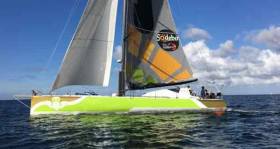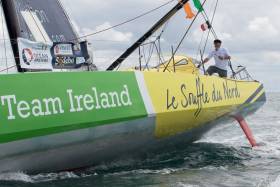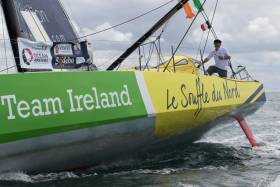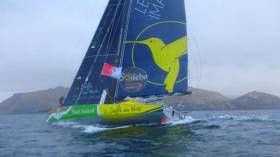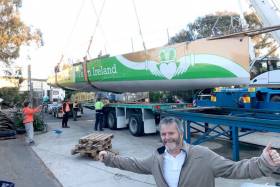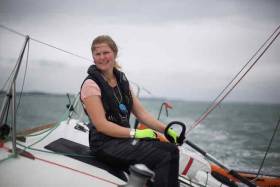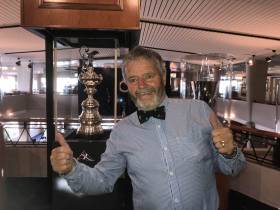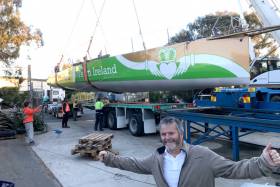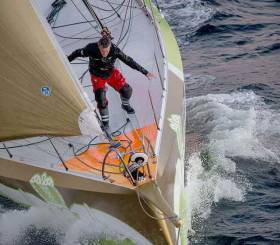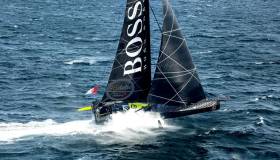Displaying items by tag: Enda O'Coineen
Enda O'Coineen is Safely Round Cape Horn
Ireland’s solo star Enda O Coineen has successfully rounded Cape Horn through the weekend in his combined-resources Open 60 Team Ireland/Soufle du Nord writes W M Nixon. In doing so he has transformed his sailing conditions from a severe 49-knots plus nor’wester west of the Horn in his final miles in the Pacific Ocean, into more gentle conditions as he shapes his course into the Atantic.
In traditional maritime parlance, the Galway veteran has “doubled the Horn”. And the extremes of weather relatively late in the season have tested his skill and resolve even further after an often very rugged passage from New Zealand.
Ireland’s Cape Horn pioneer Conor O’Brien – sailing with a crew in the 42ft Saoirse in 1924 – rounded Cape Horn in relatively benign conditions early in December. But in his much later approaches to Cape Horn, it was like winter for O Coineen.
The latter half of February is already getting late in the preferred time window, and as he neared “The Big One”, the Irish skipper and boat were tested again and again. Now this ultimate of headlands is safely astern, and though there are still thousands of miles to sail to his finish port of Les Sables d’Olonne, the most demanding hurdle of all has been safely negotiated.
Enda O’Coineen Set To Round Cape Horn Solo This Weekend
In the coming 24 hours, Enda O’Coineen is on course to sail solo around the notorious Cape Horn as he endeavours to complete his solo sailing lap of the planet.
Enda restarted his voyage in late January a little over a year since his Vendée Globe challenge came to an abrupt end, when his mast came crashing down some 180 miles south of New Zealand.
Having sailed more than half-way around the world from Les Sables in France, Enda was determined to finish what he started.
Initial plans to repair his boat changed when the opportunity arose to combine his efforts with another retired Vendée Globe team and merge as Le Souffle du Nord Kilcullen Team Ireland, with the mission to sail back to France and unofficially finish the race.
This weekend will be only one of a few recorded times that an Irish sailor has rounded the southern tip of the South American continent.
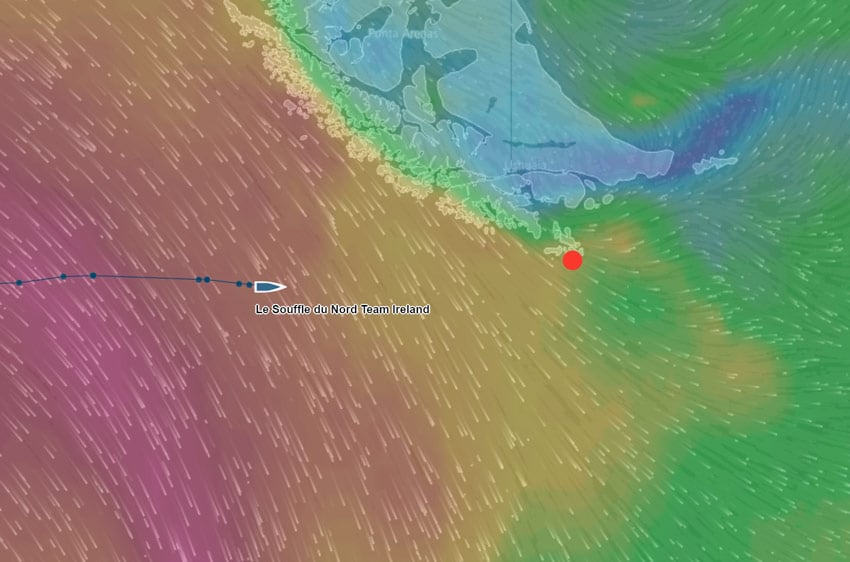
Speaking about historic event, Enda O’Coineen said: “Cape Horn is one of, if not, the most feared pieces of land to round on the planet. And it is certainly living up to its reputation as I approach with 60kph winds and roaring seas hurtling me towards the great cape.
“This will hopefully be the coldest and wildest weather I will encounter as I then turn north and start the final leg up the Atlantic Ocean and into Les Sables d’Olonne to finish what I started.
“It’s hard to explain why I put myself in this position, alone, cold, and exhausted as the bottom of the earth but as any sailor or adventurer knows as soon as you reach your destination and accomplish your goal you quickly forget about the hardship.”
Enda added: “Right now I am living on the edge, moment by moment. Having the joint backing of two teams and flying both the Irish and French flags is an honour. The work of Le Souffle du Nord and the Atlantic Youth Trust keeps me motivated during the lows.”
The timing of the rounding coincides with summer in the Southern Hemisphere, but the latitude and converging seas make Cape Horn a daunting prospect year-round.
For live tracking of Enda’s voyage visit www.teamireland.ie.
Enda O'Coineen Sets Sail to Complete a Solo Lap of the Planet
As Afloat.ie reported yesterday, in Dunedin, New Zealand, Enda O’Coineen set sail alone with the objective of sailing non-stop for 13,000 miles through the Pacific Ocean, around Cape Horn, and back up the Atlantic to Les Sables d’Olonne in France.
This epic voyage will see Enda complete the Vendee Globe race course after he was forced to retire from the race when he lost his mast on New Years Day in 2017 some 180 miles south of New Zealand. In a historic first, two Vendee Globe teams and pooled resources and joined teams to complete the voyage. French entrant Le Souffle du Nord limped into New Zealand a few days before Ireland’s only entry with serious structural damage to their hull. The French boat has now been rebuilt and Enda will sail it alone, back to France and then onto Ireland. The voyage is expected to take approximately 55 days and Enda is likely to face some extreme conditions as he sails through the Southern Ocean.
Speaking before his departure Enda said: “It is an honour to now sail under a joint French - Irish flag. Le Souffle du Nord – Kilcullen Team Ireland represents an amazing coming together of two teams. While I never wanted to have to drop out the Vendee Globe, it has added to the adventure. Just a few weeks ago a group of delegates from France and Ireland met in Auckland to wish us well and to also take a closer look at the Spirit of Adventure Trust model. It is an incredible youth development model and has played a central role in the development of New Zealand’s maritime industry, it is for those reasons that the Atlantic Youth Trust is working to replicate it.”
Solo Sailor Enda O'Coineen Restarts His Round the World Odyssey
Galway Bay's Vendee Globe sailor Enda O'Coineen left the port of Dunedin in New Zealand this morning local time under a cloudy sky and a wind from 10 to 15 knots in his new boat and is bound for France.
As Afloat.ie previously reported this week, the Irish sailor was accompanied by six young people from the Spirit of Adventure programme for his long voyage to the starting line in Les Sables D'Olonne.
Enda Readies To Resume Round-The-World Solo Voyage From New Zealand
New Zealand’s Otago Daily Times profiles Enda O’Coineen as he prepares to complete his interrupted circumnavigation of the world.
Enda’s dream looked as if it had come to an end last year when Kilcullen Voyager-Team Ireland dismasted on New Year’s Day 2017 off Dunedin, halfway through the Vendée Globe.
But after regrouping back home, plans were set in motion to resume the round-the-world route with a new IMOCA 60, and another Vendée dropout, Souffe du Norde Kilcullen Team Ireland.
First came a circumnavigation of New Zealand begun before the end of last year and completed last month — a shakedown of sorts before Enda embarks on a two-month solo voyage from Dunedin to Les Sables.
“I’m officially out of the race so we’re going to unofficially re-enter and finish it,” he says, adding about his planned departure this Friday 26 January: “You’re never really ready to go but on Friday I'll wake up and just set off. I’ve known since last year I needed to do this and so here I go.”
The Otago Daily Times has more on the story HERE.
Joan Mulloy & Enda O'Coineen Put Solo Sailing on the Westport Stage
Westport’s rising sailing star Joan Mulloy visited her home town of on Wednesday December 20th with legendary sailing veteran Enda O’Coineen, and delivered a fascinating talk at the invitation of Mayo Sailing Club reports Afloat.ie’s Clew Bay Correspondent. Seeking sponsorship, she told a packed room of well over a hundred interested guests and friends about her sailing adventures and plans, and the national and international publicity this would bring.
Melding her engineering background with her love of sailing, she has already achieved a string of successes in the highly competitive racing scene, and is one of Ireland’s most promising offshore sailors. As part of Team Ireland, she is now planning to be the first Irish woman to participate in the Solitaire du Figaro, the gruellingly competitive 1600 nautical mile four-stage race, in which she will be competing against some of the world’s best solo offshore sailors.
"Having worked at the top level of ocean racing for over 5 years, the time is right for me to take the helm” she said. “Being part of Team Ireland brings a level of professionalism, structure, and experience that will greatly enhance my campaign."
Her enthusiasm quickly spread to the listeners, and it wasn’t long before the first sponsor stepped in. Then Vendee Globe and Mini-Transat veteran Enda O’Coineen, who is now mentor to Joan, gave insights into the race he was forced to abandon in New Zealand and now plans to finish as a personal goal.
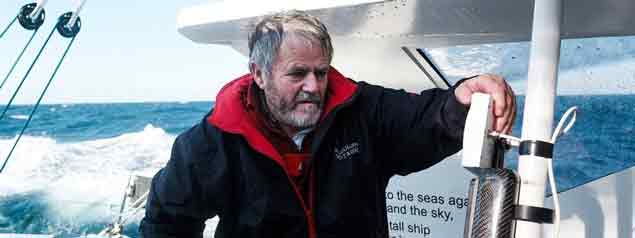 Enda O Coineen racing the Vendee Globe
Enda O Coineen racing the Vendee Globe
As he explained, disaster sometimes leads to more fame than success, and he is using his experience and insights to help young sailors launch their careers and achieve success on the international stage. He urged the local community to support Joan at the grassroots level, which is the platform that helps secure the confidence of major sponsors. To learn more about Joan, or to become a sponsor, visit: www.JoanMulloyRacing.com
Enda also talked about his work with the Atlantic Youth Trust. The plans to replace the sail training ship Asgard II are progressing, if slowly, and support for this is needed.
Not surprisingly, the event drew attendees from all around the west coast. Some of the best-known adventurers in Connacht came to hear what’s new in the world of competitive offshore racing, and the mulled wine reception in advance of the talks gave everyone a chance to get up to speed with the latest developments.
Jaimie & Mary Young, of Killary Adventure Centre were in from Connemara. Jaimie is preparing his Frers 49 Killary Flyer for his next venture to the Arctic, and fundraising is always of interest. In the meantime, he is managing an expansion of the Adventure Centre, with the addition of The Killary Lodge due for completion in June 2018.
Alex Blackwell, Irish Cruising Club and Rear Commodore of the Ocean Cruising Club for Ireland, said he liked the gentle pace of a nice cruiser, but could appreciate the subtleties of wanting to go faster than the next boat, even when cruising in conversation with Matt Molloy. Matt, an avid sailor and musician, listened attentively but made it clear he had never ever had any ambitions to take up blue water racing. He too preferred to stop along the way, and smell the roses.
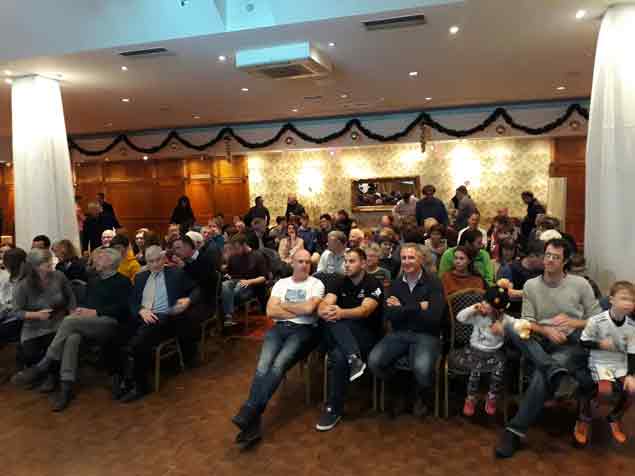 It might have been the countdown to Christmas, but in Westport people wanted to hear about top level Solo Racing
It might have been the countdown to Christmas, but in Westport people wanted to hear about top level Solo Racing
On the subject of roses, Jarlath Cunnane wanted to know if Enda shouldn’t be planning to prune roses instead of sailing across oceans now that he’s a grandfather. Enda said there was plenty of time for that, but right now he’s on a mission to finish what he started; after that, he wants to apply his knowledge to helping the up and coming young sailors, like Joan, who need to break into this competitive field. Then Jarlath asked detailed questions about the construction of Enda’s boat, which caused Enda to suggest that Jarlath may be thinking about building one himself.
Daria Blackwell, Rear Commodore of the Ocean Cruising Club, said she liked stopping along the way rather than passing anchorages by in a blur, but that following the passionate racers like Enda and Joan online was great fun.
Students from GMIT and NUI Galway came to fuel their imaginations and hopes, sensing that if Joan was able to muster the courage and the support, maybe they could too. The Galway crew that competed with success in the Fastnet Race were soaking up the details of the process of building experience and fundraising.
Joan’s childhood friends from Mayo Sailing Club’s excellent sail training programme came out in force to support her. Joan recognized those who had given her the first taste of offshore sailing, including John Lamb on whose boat she made her first exit from the protective safety of Clew Bay – and loved it. Ex-Commodores of MSC Rory Casey, Paul Murphy, and Damien Cashin arrived to lend their support, as did many other members.
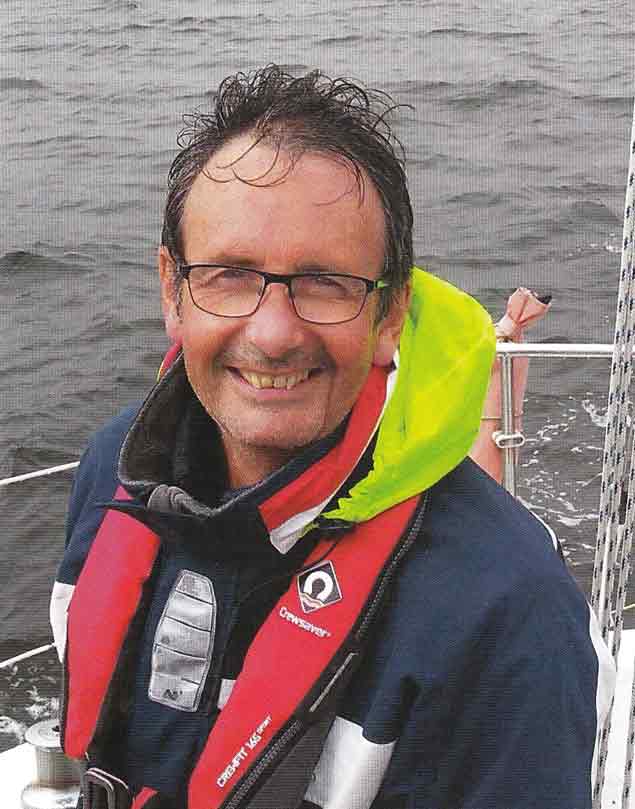 Duncan Sclare, Commodore Mayo SC, is himself a solo sailor
Duncan Sclare, Commodore Mayo SC, is himself a solo sailor
Current Commodore Duncan Sclare, himself a single-hander, joined in the praise. He also invited everyone to attend the next talk by Mini-Transat sailor Tom Dolan on the 25th of January.
Mayo Sailing Club is a happening place, that’s for certain – and not just on the water. MSC welcomes new members at its clubhouse in Rosmoney. Members literally “get out there”, and so can you. No prior experience is required. No boat is needed. Visit here
America’s Cup For Ireland? Enda O’Coineen Makes ‘Challenge’ During NZ Visit
Is Ireland about to mount a challenge for the America’s Cup?
No so fast — the photo above is just Enda O’Coineen posing with the Auld Mug as it sits prude of place in the clubhouse the Royal New Zealand Yacht Squadron in Auckland.
Former Vendée Globe contender O’Coineen was invited to the home of this year’s America’s Cup winners yesterday (Friday 24 November) along with the rest of Kilcullen Voyager Team Ireland as they paused their summer circumnavigation of New Zealand.
The trip comes ahead of O’Coineen’s ‘unofficial’ completion of his previously abandoned solo round-the-world effort, as he joins the race to Les Sables from 25 January.
But first comes a return to Ireland next week for the launch of Kilcullen Voyager Team Ireland’s Schools Adventure programme, a workshop on using ocean adventure in education, a reception hosted by the French ambassador — indeed a packed calendar of events in the run-up to Christmas.
Meanwhile, with an offshore specialist like O’Coineen in charge, and a strong Irish contingent in the current Volvo Ocean Race who might feasably lend their talents, maybe an Irish America’s Cup team isn’t such a pipe dream after all…
Enda O’Coineen's 'Kilcullen Voyager' & 'Le Souffe du Nord' Combine to Complete Vendee Globe Dream
Ireland's 2017 Vendee Globe competitor Enda O’Coineen reveals a 'marriage' of two former Vendee Globe campaigns; his own with the French IMOCA 60, Le Souffe du Nord. The Galway Bay solo sailor also confirms – from his boatyard base in New Zealand – that he intends to fulfill his dream of circumnavigating the globe and 'unofficially' finish the solo non–stop round the world race almost a year after a dismasting brought his voyage to a halt.
Greetings from Christchurch, New Zealand. It's Spring here, the birds are singing and all our KIWI friends are gearing up for Summer.
Following a ‘rebuild‘ our IMOCA 60, “ Souffe du Norde Kilcullen Team Ireland” - has come out of the yard and is due for launch today – Tuesday. Early morning it involved closing the highway, then through a large mountain tunnel leading to Lyttleton, a commercial harbour with ‘depth’ and still in a bit of a mess from the earthquake a while back.
On launching, we plan some trials and then a training leg up along the coast. Then a hop to the North Island and Wellington, the Capital, around to Tangaroa and then Auckland.
Leaving the boat secure, I am then heading back to the Irish Winter and the magic of Christmas. Then in January, we sail from Auckland back around to Dunedin and Otago Bay. Hence to complete a circumnavigation of New Zealand. Could this be a first for an Irishman? Perhaps Afloat’s Mr William Nixon can advise?
After that, it’s the ‘ Big One” and will be non-stop singlehanded to Les Sables D'Olonne and hopefully “unofficially” finish the Vendee – around the World with ‘One Stop’ – taking in a lap of Kiwiland!
Originally, after 60 days at sea, I ended up in Dunedin with no mast and a broken spirit. Such is serendipity, that The Souffe du Nord boat was broken almost in half and had a good mast. She had something big and soft, probably a whale – and arrived in the same place.
Our teams seemed destined to marry. For me it was clear on first sight. For them the courtship took a while. Interestingly our meeting point was the same place that Ernest Shackelton set out for the Antartic – 100 years previously to the month…
No less than 11 teams dropped out on this leg. Essentially you take the risks and accept the consequences. That said, it was a massive blow after such a period of intensity, to be suddenly mastless and cast adrift from a fast armada powering through the Southern Ocean was dramatic and a downer.
Then my ambition switched to survival and to get safely back to land without calling the rescues services some 200 miles out. And now that has become a simple desire to complete the circumnavigation and finish the race " unofficially” in Les Sables D'Olonne.
Last February, on returning back to Ireland - other than a few immediate talks, I went back to work ( to pay for it all). Most offers were resisted - and I could have easily dined out on my disaster story all year. As you know, in Ireland sometimes to fail is more successful that success itself.
Many people kindly wish you on – which is great – but deep down they always secretly love you to see fail. It brings great satisfaction. Human nature makes many feel great and superior when others fail. And, sure is it not great to give people this small joy? Cheers to the begrudgers and those who begrudge the begrugers – may they both self-extinguish!
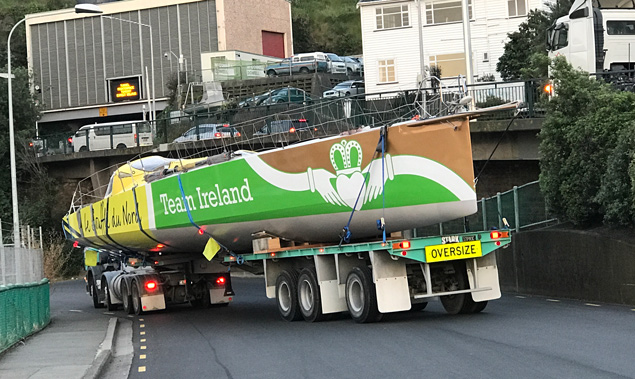 'Oversize' – The IMOCA 60 Kilcullen Voyager/Le Souffre du Nord arrives at the boatyard ready to be launched
'Oversize' – The IMOCA 60 Kilcullen Voyager/Le Souffre du Nord arrives at the boatyard ready to be launched
Originally, I was going to acquire the Souffe eu Nord Mast and their boat was to be written off. However, in the end, it made sense for me to work with them to fix their boat and sell my hull.
So now both teams have merged on an equal basis and we share the costs. The boat, was owned by a group of French businessmen based around Lille. And while keeping the partnership, it made sense for Team Ireland to take over the ownership. They have built a support group of almost 2,000 – they are passionate and a lot of fun. Their skipper, hired–in for the event Thomas Ruyant is a great sailor. However, he simply wanted out and became a bit scared of the boat, and is currently doing a two handed trans-Atlantic, the TJV.
With a courtship period, defined by logic, with ceremony and fanfare in Lille, I have been appointed their “Ambassador”. After some soul-searching they decided that they really wanted to finish.
Amongst other things, this involves taking a stuffed Hummingbird to Dunkirk. It joins my bottles of whiskey that have accompanied me on my voyage – one of which is promised to Prince Albert in Monaco who is a whiskey collector - and the other he has agreed to auction off with is in his castle for the Atlantic Youth Trust.
And why the Hummingbird? As legend has it, there was a forest fire in South America. And a flock of Hummingbirds would dive into the ocean and carry water in their beaks to dump on the fire to save the forest. Needless to say, the birds failed miserably but their message is that if everybody “does a bit” we have a chance to save the world. Go figure!
And, should you wish to understand our Souffe du Nord partners more, you can meet them when they come to Dublin on the 30th November. We have a party with the French Ambassador and at the same time announce the Atlantic Youth Trust schools programme and a workshop on using ocean adventure as an education tool in schools.
We are also working to assist Joan Mulloy from Team Ireland Racing, Gregor McGuikian also from Team Ireland Racing and to work also with Nin O'Leary of Ireland Ocean Racing, a great project.
Nin was to come on the leg up to Auckland but at the last moment had some issues at the last moment and will now likely come on the leg from Auckland back around to Dunedin/Otago.
We were fortunate to be able to facilitate Stewart Hosford of Ireland Ocean Racing of getting hold of Great American IV. Ireland is such a small place and there is a powerful logic for all involved in the sport, and the development of ocean sailing, to work together,
These ocean projects are incubating professional sailing teams. It's ‘baby steps’ for the moment and it's necessary to focus on one step at a time and sure who knows where the journey may lead? A circumnavigaton of some more Pacific countries and Atlantic islands on route?
Enda O'Coineen Flies Out to Finish Round–the–World Voyage
Solo sailor Enda O'Coineen rejoins his Vendee Globe yacht Kilcullen Voyager this weekend some 11–months after its dismasting off New Zealand on New Year's Day. That's according to the Irish Times Sailing Column this morning here. The 61–year–old flies who flies out to Christchurch today told the newspaper he wants 'to finish what I started'.
As Afloat.ie reported at the time, O'Coineen spent five days in January sailing Kilcullen Voyager just 240 miles under jury rig (when his best days run while in full racing trim was 395 miles) trying to make the coast of Dunedin. He succeeded without having to call for aid from the rescue services but admitted his dream of circumnavigating the world was 'shattered'.
The Irish Times has much more on the story here.
How Much in the Sponsorship Pot for all These Irish Offshore Sailing Superstar Hopefuls?
There have been several Irish offshore racing sailors who have been making national and world headlines for some years now, but in recent weeks and months the wave of new enthusiasm for the big ticket events has surged to fresh heights.
One of the stories underlying all this is the potential for a specialist marine industry base in Cork Harbour serving the continuous needs of the most advanced racing machines, and providing a launch pad for global campaigns. The idea has been around for some time now, but as reported in Afloat.ie as long ago as April 1st 2015, while the goodwill may be there, a firm decision is still awaited.
Local minister Simon Coveney has since moved on from the Marine to other Government departments. His present very senior role in representing Ireland through the Department of Foreign Affairs in decidedly turbulent times will mean that the needs of something so difficult to gauge for significant political and economic benefits will scarcely be top priority.
Yet for the many leading Irish sailors – both men and women – who have launched themselves into the decidedly uncertain world of top level professional competition, the problem of resources and facilities to keep the show on the road is always present, and frequently at crisis levels. W M Nixon wonders how there is going to be enough in the sponsorship pot – both nationally and globally – to help them all fulfill their dreams.
On Tuesday, Afloat.ie received confirmation of a “virtual press conference” in Cork, in other words a clearcut announcement that Nin O’Leary’s co-skippering of the IMOCA 60 Hugo Boss with Alex Thompson was going to move on to a full-blooded Vendee Globe campaign by O’Leary himself, possibly with a new boat.
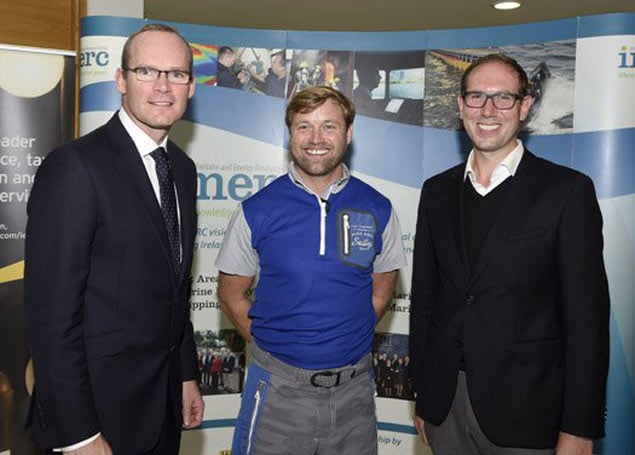 The then Minister for the Marine Simon Coveney, Hugo Boss skipper Alex Thomson, and Stewart Hosford at the announcement in Cork in 2015 of a possible international offshore racing hub on Haulbowline Island.
The then Minister for the Marine Simon Coveney, Hugo Boss skipper Alex Thomson, and Stewart Hosford at the announcement in Cork in 2015 of a possible international offshore racing hub on Haulbowline Island.
In the meantime, the word on the waterfront is that the two skippers may do the two-handed Barcelona World Race 2018 in the current boat. But beyond that, the campaign plan for the charismatic O’Leary, mentored by Thomson and orchestrated by Stewart Hosford, is rumoured to be the building up of enough resources to keep this boat, yet also build a new one.
This is because the boat is still almost state-of-the-art, she has some features still absent in other boats, and could be serious opposition in someone else’s hands. Thus the ideal scenario is to maintain control of their current technology and design, while moving on to the next stage of development with an even more advanced boat for the Vendee Globe in 2020.
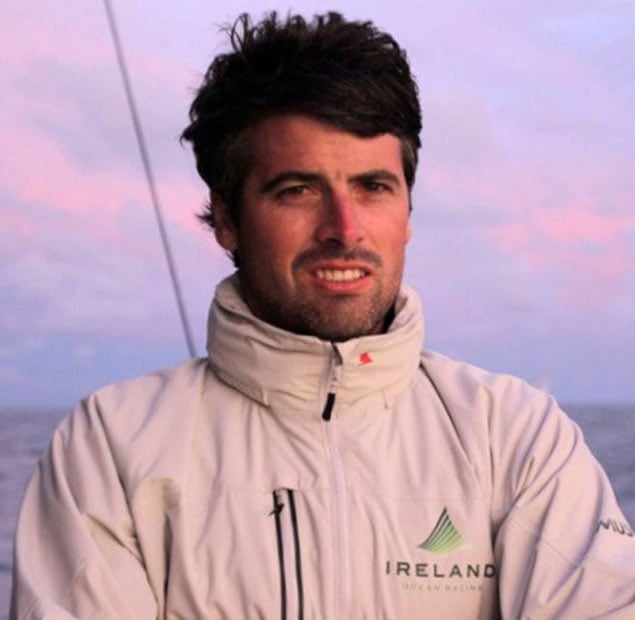 Nin O’Leary – a charismatic figure for Ireland’s younger sailors
Nin O’Leary – a charismatic figure for Ireland’s younger sailors
We’re talking mega-bucks here, and the relationship with Hugo Boss has been very fruitful, but the elephant in the room - which hasn’t been mentioned yet - is how long will the Hugo Boss sponsorship continue?
This may all become clearer within the next ten days, as Thomson, O’Leary and Hugo Boss are headed for Ireland, with Cork in their sights on Monday 28th and Tuesday 29th August, and then they’re in Dun Laoghaire for a very public appearance on Wednesday August 30th, and staying until the Friday, September 1st for the ongoing launch of their new brand Ireland Ocean Racing.
This puts them top of the billboards. But we mustn’t let it blind us to the hopes of other campaigners, and on Thursday of this week, Tom Dolan made his final public appearance in Ireland before returning to France for the countdown towards the start of the Mini Transat 2017 from La Rochelle at the beginning of October.
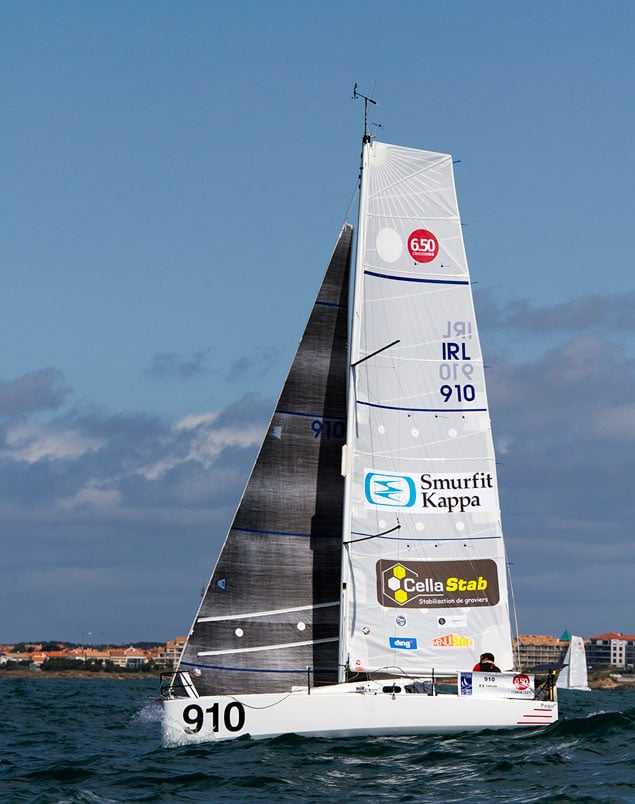 Although Tom Dolan has some sponsorship for IRL 910, there is still a shortfall in funding for the Mini Transat 2017 which starts at the beginning of October from La Rochelle
Although Tom Dolan has some sponsorship for IRL 910, there is still a shortfall in funding for the Mini Transat 2017 which starts at the beginning of October from La Rochelle
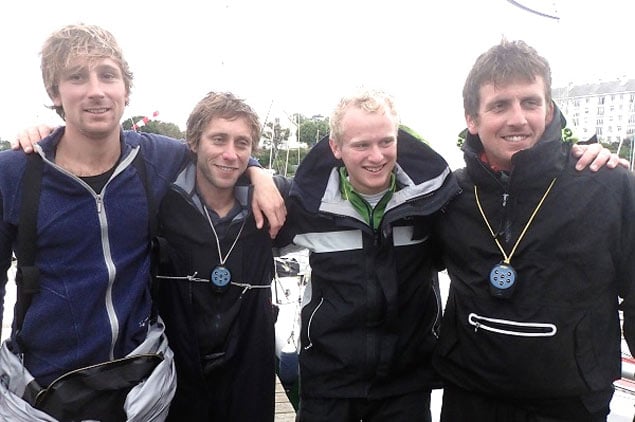 Tom Dolan (right) and fellow skippers in the Mini 650 class at Concarneau. The camaraderie and mutual help among the sailors contributes to France’s dominant position in short-handed sailing
Tom Dolan (right) and fellow skippers in the Mini 650 class at Concarneau. The camaraderie and mutual help among the sailors contributes to France’s dominant position in short-handed sailing
Although Tom has some support backers whose logos appear on his sails, he makes no bones about his overall situation, as his Pogo 3, IRL 910, currently enters races under the name of “Still Seeking a Sponsor”. Whether his presentation in the National YC on Thursday will turn on any money taps in Ireland remains to be seen, the fact is that it’s in France he makes most impact. But in Dun Laoghaire, his burning enthusiasm left an abiding impression, for although his chosen life-path may be more exciting than running the small family farm in Meath, there are times when it’s a massive struggle.
Tom is one of several Irish international offshore wannabees and established skippers who have made a point of having the cup of coffee with Marcus Hutchinson. Hutchinson has transformed himself from being a young sailor who first learned his craft in Howth into an international sailing campaign management figure who maintains his Irish connections through Kinsale, yet is now a key presence at the French-led cutting edge of specialist offshore programmes.
 Marcus Hutchinson is first Port of Call for anyone seriously contemplating a short-handed offshore campaign
Marcus Hutchinson is first Port of Call for anyone seriously contemplating a short-handed offshore campaign
It’s rumoured that in Brittany he has access to a large warehouse full of IMOCA 60s and Open 40s and whatnot. What we do know for sure is that he was very much the background force in Paul Meilhat’s stunning victory in the IMOCA 60 SMA in the recent Rolex Fastnet Race, a neatly-read campaign whose success was highlighted by the inescapable fact that Hugo Boss finished eighth out of the nine IMOCA 60s competing.
SMA with her dagger boards was optimized for windward work, whereas Hugo Boss with her foils most emphatically wasn’t. But while those in the know are aware of this, Joe Public simply sees the final results and takes it from there.
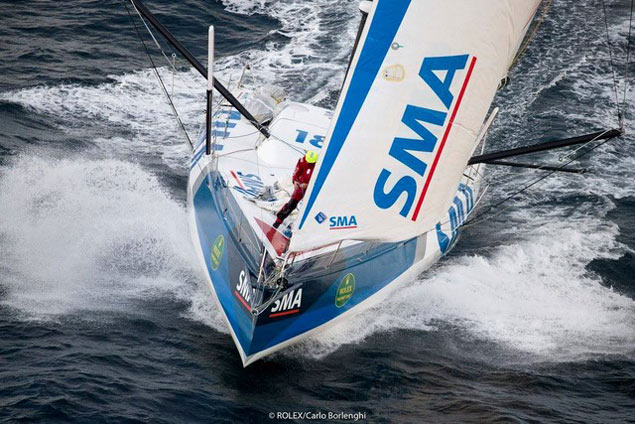 The Marcus Hutchinson-managed SMA was convincing winner of the IMOCA 60 Class in the Rolex Fastnet Race 2017. Photo: Carlo Borlenghi
The Marcus Hutchinson-managed SMA was convincing winner of the IMOCA 60 Class in the Rolex Fastnet Race 2017. Photo: Carlo Borlenghi
Marcus Hutchinson’s deep well of sound advice is available to those who seek him out, and he is generous with his knowledge and sensible thoughts. Talking to Afloat.ie yesterday morning, he made the point that of the current wave of French superstars in the bigger boats, many have done the Figaro Solo at least a dozen times, and he reckons that setting out to take on the Vendee Globe straight from a career – however successful – in fully-crewed boats, is akin to taking on Everest solo without first trying a few smaller mountains on your own.
The list of those specialist sailors from Ireland who have made a point of seeking advice and assistance at some stage from Marcus Hutchinson is both impressive and fascinating, as it includes Damian Foxall, Justin Slattery, Enda O'Coineen, David Kenefick, Joan Mulloy, Sean McCarter, Tom Dolan and most recently Conor Fogerty.
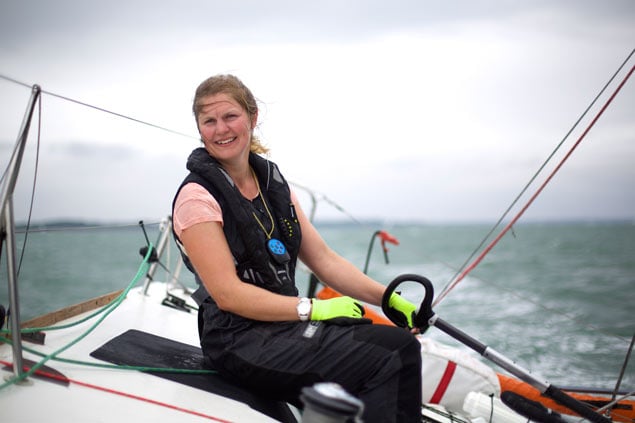 Joan Mulloy of Westport in County Mayo has secured a Figaro through Marcus Hutchinson, but still requires sponsorship
Joan Mulloy of Westport in County Mayo has secured a Figaro through Marcus Hutchinson, but still requires sponsorship
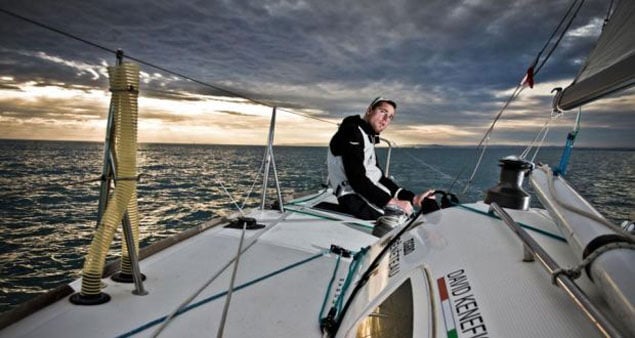 David Kenefick of Cork is another solo sailor who was guided into the Figaro Class by Marcus Hutchinson
David Kenefick of Cork is another solo sailor who was guided into the Figaro Class by Marcus Hutchinson
And a salient fact which emerges in talking to some of them is the thought that while the Alex Thomson/Hugo Boss campaign was impressive, its central ethos of being stand-alone was ultimately counter-productive.
Two of the lone skippers mentioned above went so far as to say that if the Hugo Boss campaign had been prepared to mix it a bit more with the strongholds of French single-handed sailing in Brittany, then they would have won the Vendee Globe instead of coming second.
That’s undoutedly one for the speculation mill. But it gets a certain reinforcement from a statement this week from Nin O’Leary, to the effect that moving the base from Portsmouth to Cork would have the beneficial result of making the major French centres seem more accessible, as there’s almost a feeling of being trapped in the Eastern Solent, whereas in Cork it’s open water – and open thinking - all the way to Ushant and beyond.
This desire for open water and open thinking is spreading. One of the most interesting news items of recent weeks was that Olympic Silver Medallist Annalise Murphy hoped to secure a berth aboard Dee Caffari’s Volvo 65 for the up-coming Volvo World Race. Unfortunately the knee injury Murphy exacerbated with a spectacular capsize at the conclusion of becoming the International Moth Women’s World Champion 2017 on Lake Garda has put that idea on hold, but this shift of interest from the grind of Olympic training on a tedious four year cycle to the more stimulating world of big-time offshore stuff, with maior events coming up in rapid succession, reflects a discernible pattern of changing public awareness.
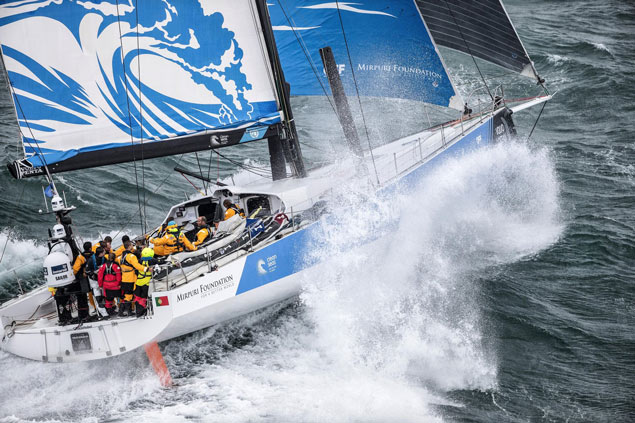 The new Volvo 65 Turn the Tide on Plastic. Olympic Silver Medallist Annalise Murphy had to defer taking up a berth on Dee Caffari’s Volvo 65 because of a knee injury sustained during a capsize in the Moth Worlds at Lake Garda
The new Volvo 65 Turn the Tide on Plastic. Olympic Silver Medallist Annalise Murphy had to defer taking up a berth on Dee Caffari’s Volvo 65 because of a knee injury sustained during a capsize in the Moth Worlds at Lake Garda
So Olympic sailing, ever mindful of the need to continue to attract public attention by whatever means, is going to include a test offshore series, probably for two person boats, in the Tokyo Olympics in 2020.
This is of particular interest to any Irish sailor desperately seeking sponsorship, for the reality is that on our island, there are only half a dozen sports – if that - which are big enough to make an impact on their own. The minority sports - sailing included - only figure significantly in public awareness if they come up in the Olympic searchlight.
That Olympic searchlight in turn encourages others to get involved, thereby stretching the cloak of sponsorship ever thinner. So it will be some time, if ever, before we see a joint approach to the challenge of raising sponsorship for this branch of sailing. And Heaven knows, but it’s difficult enough to get an effective short-handed sailing campaign of international standard up to speed without the endless worry of finding the money. Yet that’s the way it is. But if you really do find the challenge irresistible, Afloat.ie’s advice is to make arrangements to have a cup of coffee with Marcus Hutchinson before you do anything else.




























